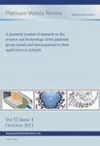Platinum Metals Review - Volume 27, Issue 1, 1983
Volume 27, Issue 1, 1983
-
-
Platinised Titanium Electrodes for Cathodic Protection
More LessBy By P. C. S. HayfieldOver the past quarter of a century a combination of platinum and titanium has been used increasingly as an electrode material for the cathodic protection of steel in marine environments and underground structures. As a result of accumulated experience gained in many situations it is now possible to set guidelines within which the material may be used with confidence, thus greater application is probable.
-
-
-
The Electrodeposition of Palladium from Chelated Complexes
More LessBy By Ronald J. MorrisseyRecent advances in brightener chemistry have made it possible to electrodeposit microcrack-free, (111) oriented palladium of very high brightness and lustre. This preferred crystallographic orientation results in a major improvement in resistance to wear, still further increasing the attractiveness of palladium as a replacement for electrodeposited gold.
-
-
-
The Oxidation of Rhodium-Platinum
More LessAuthors: By A. R. McCabe and G. D. W. SmithThe oxidation behaviour of platinum and its alloys at high temperatures is of fundamental importance to its application as both a structural material and a catalyst in a wide range of industrial processes. One of the principal factors determining the efficiency of a catalyst is its surface condition and this in turn depends upon both the initial surface preparation and the changes in surface structure and composition that take place during use. During the manufacture of nitric acid from ammonia a rhodium-platinum catalyst gauze is employed, and under the reaction conditions the surface of the catalyst is altered. The processes involved in this change are not yet fully known, but a study undertaken to provide a more detailed characterisation of the oxide layer formed upon the surface of rhodium-platinum is now reported and may have relevance both to its use as a catalyst in ammonia oxidation and as a structural material.
-
-
-
The Development of Ideas on Heterogeneous Catalysis
More LessBy By Professor A. J. B. RobertsonSince the discovery by Davy in 1817 of catalytic oxidation on the surface of platinum there has been much discussion of the underlying reasons for the occurrence of heterogeneous catalysis. Early ideas of Liebig found little favour with Berzelius, Ostwald and others. The adsorption theory of Faraday became generally accepted, although alternative views were proposed over a long period. Langmuir put the concepts of Faraday into definite form, and his formulations and developments of them have been used up to the present.
-
Volumes & issues
-
Volume 58 (2014)
-
Volume 57 (2013)
-
Volume 56 (2012)
-
Volume 55 (2011)
-
Volume 54 (2010)
-
Volume 53 (2009)
-
Volume 52 (2008)
-
Volume 51 (2007)
-
Volume 50 (2006)
-
Volume 49 (2005)
-
Volume 48 (2004)
-
Volume 47 (2003)
-
Volume 46 (2002)
-
Volume 45 (2001)
-
Volume 44 (2000)
-
Volume 43 (1999)
-
Volume 42 (1998)
-
Volume 41 (1997)
-
Volume 40 (1996)
-
Volume 39 (1995)
-
Volume 38 (1994)
-
Volume 37 (1993)
-
Volume 36 (1992)
-
Volume 35 (1991)
-
Volume 34 (1990)
-
Volume 33 (1989)
-
Volume 32 (1988)
-
Volume 31 (1987)
-
Volume 30 (1986)
-
Volume 29 (1985)
-
Volume 28 (1984)
-
Volume 27 (1983)
-
Volume 26 (1982)
-
Volume 25 (1981)
-
Volume 24 (1980)
-
Volume 23 (1979)
-
Volume 22 (1978)
-
Volume 21 (1977)
-
Volume 20 (1976)
-
Volume 19 (1975)
-
Volume 18 (1974)
-
Volume 17 (1973)
-
Volume 16 (1972)
-
Volume 15 (1971)
-
Volume 14 (1970)
-
Volume 13 (1969)
-
Volume 12 (1968)
-
Volume 11 (1967)
-
Volume 10 (1966)
-
Volume 9 (1965)
-
Volume 8 (1964)
-
Volume 7 (1963)
-
Volume 6 (1962)
-
Volume 5 (1961)
-
Volume 4 (1960)
-
Volume 3 (1959)
-
Volume 2 (1958)
-
Volume 1 (1957)
Most Read This Month

Most Cited Most Cited RSS feed
-
-
Metal-Ligand Exchange Kinetics in Platinum and Ruthenium Complexes
By By Jan Reedijk
-
-
-
The Preparation of Palladium Nanoparticles
By By James Cookson
-
-
-
Diesel Engine Emissions and Their Control
By By Tim Johnson
-
-
-
Recycling the Platinum Group Metals: A European Perspective
By By Christian Hagelüken
-
-
-
A Healthy Future: Platinum in Medical Applications
Authors: By Alison Cowley and and Brian Woodward*
-
-
-
Palladium-Based Alloy Membranes for Separation of High Purity Hydrogen from Hydrogen-Containing Gas Mixtures
Authors: By Gennady S. Burkhanov, Nelli B. Gorina, Natalia B. Kolchugina, Nataliya R. Roshan, Dmitry I. Slovetsky and Evgeny M. Chistov
-
-
-
A Review of the Behaviour of Platinum Group Elements within Natural Magmatic Sulfide Ore Systems
Authors: By D. A. Holwell and I. McDonald
-
-
-
Platinum as a Reference Electrode in Electrochemical Measurements
Authors: By Kasem K. Kasem and Stephanie Jones
-
-
-
Carbon Nanotubes as Supports for Palladium and Bimetallic Catalysts for Use in Hydrogenation Reactions
Authors: R. S. Oosthuizen and V. O. Nyamori
-
- More Less

